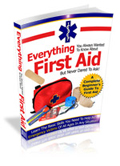Welcome to fractures Guide
Post Operative Management In Patella Fractures Article
 To bookmark this article for further reading, click here.
To bookmark this article for further reading, click here.
Ankle Fractures Are More Than Just Sprains
For many years, people didn't fully understand what fractures were. In fact, they often thought they were less serious than a broken bone, when they are actually one in the same.
You would hear people make comments like, "well at least it's only a fracture and nothing is broken." Because of these mistaken beliefs, many fractures took twice as long to heal, as they should have because they were not given the proper treatment or taken seriously enough.
Ankle fractions are often not taken seriously enough either. The ankle is the part of our leg that supports most of the weight of our body so any injury to the ankle should be taken seriously, specifically ankle fractures.
An ankle fracture in either a complete or a partial break of the bone in the ankle. Ankle fractures can be less serious injuries like a small piece of bone being stripped or pulled or they may be serious where the fibula or tibia re shattered quite severely.
The most common cause of ankle fractures are the ankle being twisted or rolled either outward or inward. Both of these instances can cause instant and sometimes severe pain. Without proper medical attention, we have no way of knowing the severity of the break so we may be doing further damage to a very important part of the body.
Many people mistake ankle sprains for ankle fractures, but they are very different and require different treatment as well as early treatment. Ankle sprains and ankle fractures can occur at the same time, which is why it is paramount that the patient seeks medical treatment as soon as possible.
Fracture Symptoms
Symptoms of ankle fractures can be just a few or many.Some of the more common symptoms are pain at the ankle or possibly right up to the knee, swelling on just the ankle or possibly the entire leg, bruising shortly after the injury, inability to walk or very difficult, difference of appearance from the uninjured ankle and a bone sticking out of the skin, which requires immediate attention.
It is very important to see a doctor as soon as you possibly can. However, if you can't get to the hospital right away, there are a few things you can do to help. This method of home treatment is considered the R.I.C.E. method:


